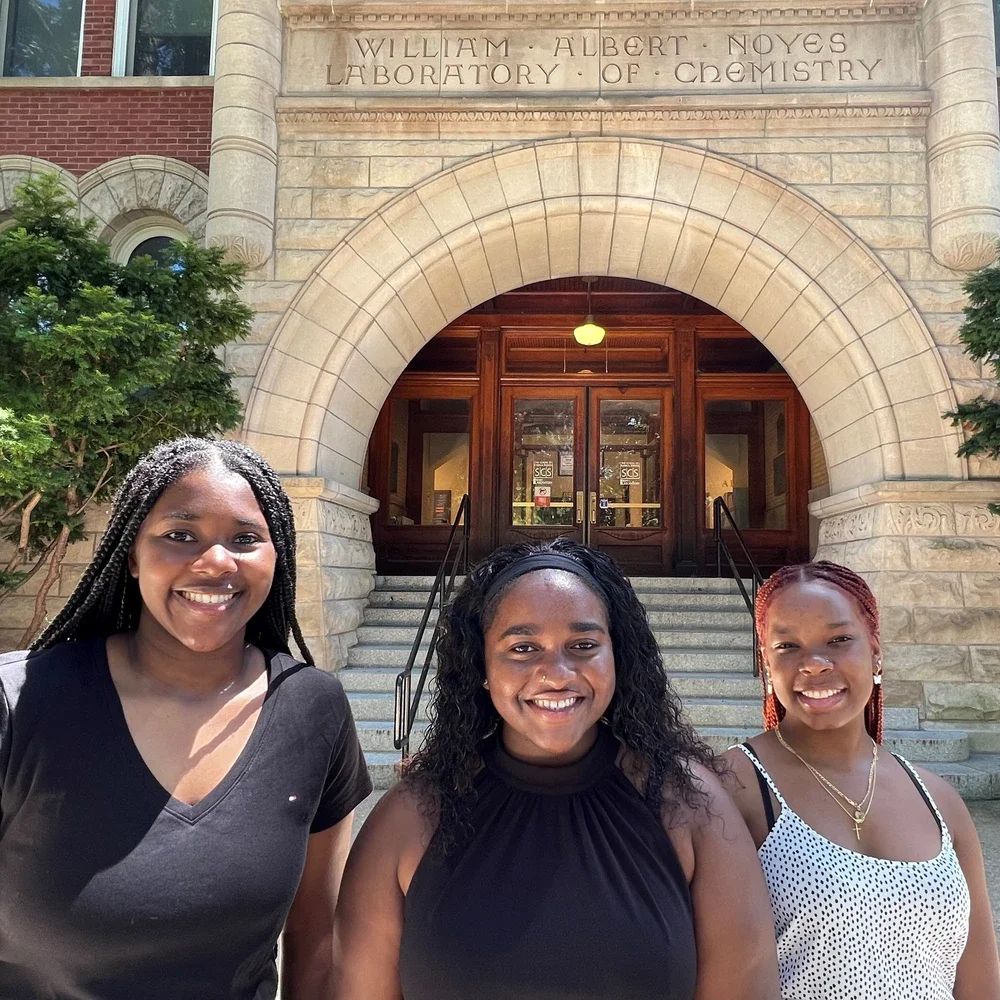
In 2019, the Department of Chemistry established the St. Elmo Brady Scholars Program to provide summer research opportunities at Illinois for undergraduates from Tougaloo, Howard, Fisk, and Tuskegee universities, which all share an important legacy with UIUC.
The chemistry programs at these four Historically Black Colleges and Universities (HBCUs) were founded by St. Elmo Brady, who graduated from Illinois in 1916 and was the first African American to receive a PhD in chemistry in the United States.
Enleyona Weir, from Tougaloo College in Mississippi, was the first Brady Scholar in the summer of 2019, and is now a PhD student in chemistry at Illinois, and this fall, Micah Robinson, who was a St. Elmo Brady scholar last summer in 2021, is a new PhD student in chemistry at Illinois.
The Department's newest group of St. Elmo Brady scholars — Alexis Duncan, Kaya Moody, and Kyla Duke from Howard University — just finished 10 weeks of a summer research experience in chemistry labs on the UIUC campus. Read more below about the summer research experiences of Alexis Duncan and Kaya Moody.
Learn more about Diversity and Inclusion in Chemistry at Illinois.
Alexis Duncan
An undergraduate at Howard University in the Class of 2024, Duncan spent this past summer doing research in the lab of Professor Liviu Mirica.
Favorite Spot on the UIUC Campus: Bruce D. Nesbitt African American Cultural Center.
Favorite UIUC Class: SROP Professional Development classes.
Why chemistry? I chose to major in chemistry because I like that it's a central science incorporating math, physics, medicine, and biology. I like that chemistry is fundamental to our lives and essential in providing basic needs like food, clothes, medications, and clean water. Being a chemist is important to me because I want to use my knowledge to solve problems related to health and materials.
Your summer research experience in one word: Rewarding.
Describe your project: I conducted organic synthesis of 1,4,7-triazacyclononane ligands for potential use as imaging agents for early diagnosis of AD and chemical biology tests to determine the ability of the ligands to prevent copper toxicity in vitro.
What was a highlight for you? Working in the fume hood, biosafety cabinet, learning how to take an NMR, and establishing relationships with my PI, mentors, and other grad students. And meeting other minority students in the SROP and establishing life-long friendships with other Black students in STEM
What did you learn? After taking organic chemistry last year, I had many "aha" moments when I was interpreting the mechanisms for the 1,47-triazacyclononane ligand synthesis.
Kaya Moody
An undergraduate at Howard University in the Class of 2024, Moody spent this past summer doing research in the lab of Professor Jefferson Chan.
Favorite Spot on the UIUC Campus: The Illini Union.
Your summer research experience in one word: Inspiring.
Describe your project: I had the opportunity to work alongside Prof. Jefferson Chan and Katie Brady exploring photodynamic therapy resistance mechanisms by targeting glutathione levels within different cancer cell lines. Photodynamic therapy is a noninvasive method of cancer treatment which works by focusing on a light-targeted area of the body and producing singlet oxygen, a reactive oxygen species which has been found to be deadly to cancerous cells hence its FDA approval to treat various forms of cancer. However, some forms of cancer are resistance to this method of treatment, and we hypothesized that this is due to higher levels of glutathione within certain cancerous cell lines. In order to test this theory, we had to quantify the level of glutathione within various cancer cell lines, execute photodynamic therapy on those same cells, and evaluate the cell viability following treatment.
What was a highlight for you? The best part of my summer research experience was being able to understand my project to the point where I could explain it to vast groups of people. At the Illinois Summer Research Symposium (ISRS) I had the opportunity of interacting with nearly a hundred people from various backgrounds and allowing them to understand my project. I was especially excited to see the friends that I made this summer along with my PI and mentor show up to my oral and poster presentation at ISRS. Having that support system present, though it had been built in such a small amount of time, at my presentations allowed me to excel with my delivery which I am truly appreciative of.